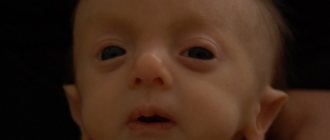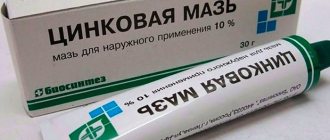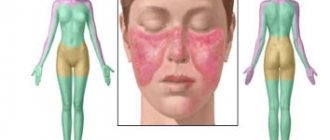Down syndrome is a chromosomal abnormality that manifests itself in a variety of congenital symptoms: both physical and abnormalities in mental development. In all cases, cognitive development delays are noted, but the severity varies greatly, so that most patients are characterized by “slightly” or “moderately” limited physical abilities.
Girl with Down syndrome
Unfortunately, people with Down syndrome often have other health problems, such as:
- heart defects
- hearing defects
- intestinal disorders
- thyroid changes
- skeletal disorders
- eye disorders
The severity of these problems varies greatly depending on the individual.
Down syndrome is the most common chromosomal abnormality in humans, and the risk of conceiving a child with Down syndrome increases with the mother's age. The disease can be diagnosed at birth or even earlier through prenatal screening.
There is no cure for this syndrome, but an integrated approach introduced from the first months of life can support good development of basic skills, allowing a calm and productive life.
Life expectancy has increased significantly over the past few decades, from 25 years in 1983 to 60 or more today.
Description
Down syndrome is a congenital chromosomal abnormality characterized by an increase in the number of chromosomes.
In each egg, after fertilization, the chromosomes are doubled, eventually becoming 46, of which 23 belong to the mother’s cell, and the other 23 belong to the father’s cell. With Down syndrome, a deviation from the norm occurs, which is accompanied by the discovery of an additional chromosome in the 21st pair. Thus, the total number of chromosomes changes and is equal to 47. Such changes lead to the formation of a “syndrome”, which implies the presence of certain signs or characteristic features.
Down syndrome is the most common genetic anomaly, occurs in all countries and does not depend on social status, nationality, skin color, etc. It occurs with equal frequency among both girls and boys. The exact cause of this genetic abnormality is unknown. It is believed that the birth of a child with Down syndrome is more common in women over 35, so they are at risk and are subject to more careful attention from doctors. However, there are cases when young mothers give birth to children with this pathology.
Children with Down syndrome are called "sunny". Despite their slower development, these children are still learnable. A loving atmosphere in the home and constant additional activities are important to them. Such a child requires more attention and effort on the part of the parents, thanks to which it is possible to achieve social adaptation.
Given that these children are born with numerous health problems, constant monitoring by the attending physician is required, often even by several specialists from different fields of medicine. Such comprehensive observation by doctors helps to select the most effective treatment, which is necessary in creating all the conditions for a comfortable life for both the child and his parents.
Is it worth doing?
Screening is strongly recommended for a woman if she is over 35 years old, if the father of the child is a close relative, or if she has previously given birth to children with chromosomal abnormalities. The doctor may also refer a woman for screening who has recently received radiation, x-rays, or other radiation.
In addition, diagnosis is mandatory for expectant mothers who become pregnant due to a viral or bacterial pathology, have had a history of premature birth, miscarriages, or have taken illicit medications during conception.
If one of the diagnostic procedures indicates signs of Down syndrome during pregnancy, the woman has the right to terminate it at her own request until the 22nd week.
Of course, the possibility of spontaneous abortion during research may be an unpleasant price to pay for the correct result, especially if the child does not have this diagnosis and turns out to be healthy. Therefore, not all women agree to undergo testing for Down signs during pregnancy.
Even if, due to moral or religious beliefs, the expectant mother knows for sure that she will not terminate the pregnancy if a deviation in the baby is confirmed, in any case, everyone without exception needs to undergo diagnostics. At least in order to find out the truth about the health of your child in time and mentally prepare yourself and your loved ones for his birth, if he turns out to be special.
Forms of Down syndrome
- Trisomy means having three chromosomes instead of two. Research analyzes have confirmed that an extra chromosome of a group of autosomes leads to abnormal development of the embryo. The occurrence of Down's disease is associated with the “wear and tear” of the female body and diseases of the genital organs, with episodes in a woman’s life when children were stillborn or died at an early age.
- Translocation Down syndrome is the transfer of a gene or chromosome fragment to another position on the same or another chromosome. The 13-15th and 21-22nd autosomes are involved in the translocation, but the number of chromosomes in the set remains equal to 46. The probability of having a sick child in this case depends on the father - the carrier of the mutation, and not on the age of the mother. Babies with translocation syndrome make up 5% of the total number of children with Down syndrome.
- Down syndrome with mosaicism
Mosaicism - the third type of chromosomal abnormalities is expressed by the presence in some cells of the normal number of chromosomes 46, and in others - 47 chromosomes, i.e. trisomy on the 21st pair of chromosomes. The frequency of this phenomenon is 1% of the total number of children with Down syndrome. Some children have pronounced typical features of the pathology or mild ones. They are intellectually stronger than children with translocation Down syndrome. The occurrence of an abnormal set of chromosomes is associated with a disruption of certain phases of meiosis. At the age of 35, a woman’s body undergoes a change in hormonal balance and changes in the formation of eggs.
Is it possible to detect Down syndrome using an ultrasound?
There is a small chance that a specialist will detect Down syndrome on an ultrasound. These include an increase in skin volume in the back of the head, a decrease in the size of the hip, or cysts in the brain. According to doctors, Down syndrome cannot be diagnosed by ultrasound. This test will not detect the expected risk of trisomy 21.
Ultrasound imaging at 20 weeks can be used to screen for Down syndrome in the fetus.
1 Ultrasound of a fetus with a large bladder 2 Enlarged NT and missing nasal bone in an 11-week fetus with Down syndrome
Echo signs of Down syndrome on ultrasound, which indicate an increased risk when observed in the second trimester of pregnancy.
A fetus with Down syndrome may have a small or absent nasal bone, large cerebral ventricles, a thick nuchal fold, and an abnormal right subclavian artery. The presence or absence of many signs is more accurate.
Find out more Characteristic signs of Klippel-Feil syndrome
Mechanism of occurrence of the syndrome
Down syndrome is a genetic pathology that develops in the fetus at the time of conception if a defective egg and sperm merge. In about 90% of cases, the cause is a defective egg with 24 chromosomes instead of 23, and in about 10% it may be a defective sperm. The formation of such defective germ cells can be influenced by illnesses of the mother or father, stress, bad habits, poor and irrational nutrition, everything that in one way or another can affect the division of germ cells. But the course of pregnancy and childbirth does not affect the development of Down syndrome.
A special cell protein will be to blame for the fact that germ cells contain an extra chromosome. It has the function of stretching chromosomes to the poles of the cell during division, so that as a result each cell receives equal amounts of genetic information. If the protein has a defect, then on one side the microtubule pulling the chromosome will be thin and defective, and a stronger tube from another forming cell will pull it towards itself, to the opposite pole. After this, the cells begin to separate from each other, turning into two full-fledged formations - but one will have 22 chromosomes, and the other will have 24. This defective cell can give life to a baby with Down syndrome.
Similar problems can arise when exposed to the following factors:
- consanguineous marriages with carriers of the same mutations. The closer the degree of relationship, the more likely mutations are;
- pregnancy before 18 years of age, since the body is not yet mature, and there may be defects in cell division;
- late pregnancy: after 35 years (for a woman) and after 45 years (for a man) with the accumulation of a load of mutations;
- carriage of defects in 21 pairs of chromosomes.
But for the most part, the presence of Down syndrome is the result of a spontaneous mutation for which no one is to blame.
Is it possible to prevent pathology?
Preventive measures help avoid the development of many diseases in the fetus. But, unfortunately, there is no prevention of genetic abnormalities. However, doctors give several recommendations to at least minimally reduce the risk of developing Down syndrome:
- pregnancy needs to be planned;
- you should not delay the birth of your child: it is advisable that the mother’s age does not exceed 35 years;
- taboo on family ties between partners;
- before and after conception you need to consult a geneticist;
- at the planning stage, and then in the first trimester, a woman is recommended to take folic acid and multivitamins.
Once you become pregnant, you need to register with an antenatal clinic as early as possible. This is a guarantee of timely diagnostic analyzes and tests aimed at identifying signs of various pathologies of the embryo.
Causes of Down syndrome
Normally, the cells of the human body contain 23 pairs of chromosomes (normal female karyotype 46,XX; male - 46,XY). In this case, one of the chromosomes of each pair is inherited from the mother, and the other from the father. The genetic mechanisms for the development of Down syndrome lie in a quantitative disruption of autosomes, when additional genetic material is added to the 21st pair of chromosomes. The presence of trisomy on chromosome 21 determines the features characteristic of Down syndrome.
The appearance of an additional chromosome can be caused by a genetic accident (non-disjunction of paired chromosomes during oogenesis or spermatogenesis), a violation of cell division after fertilization, or the inheritance of a genetic mutation from the mother or father. Taking these mechanisms into account, genetics distinguishes three types of karyotype abnormalities in Down syndrome: regular (simple) trisomy, mosaicism and unbalanced translocation.
Most cases of Down syndrome (about 94%) are associated with simple trisomy (karyotype 47,XX, 21+ or 47,XY, 21+). In this case, three copies of the 21st chromosome are present in all cells due to disruption of the separation of paired chromosomes during meiosis in the maternal or paternal germ cells.
About 1-2% of cases of Down syndrome occur in the mosaic form, which is caused by impaired mitosis in only one cell of the embryo, which is at the blastula or gastrula stage. In mosaicism, trisomy of the 21st chromosome is detected only in derivatives of this cell, and the rest of the cells have a normal chromosome set.
The translocation form of Down syndrome occurs in 4-5% of patients. In this case, the 21st chromosome or its fragment is attached (translocated) to one of the autosomes and, during meiosis, moves along with it into the newly formed cell. The most common “objects” of translocation are chromosomes 14 and 15, less often - on 13, 22, 4 and 5. Such rearrangement of chromosomes can be random or inherited from one of the parents who is a carrier of a balanced translocation and has a normal phenotype. If the carrier of the translocation is the father, then the probability of having a child with Down syndrome is 3%; if the carriage is associated with maternal genetic material, the risk increases to 10-15%.
Causes
Down syndrome is a consequence of trisomy 21: in 94% of cases simple trisomy 21 is found, approximately 4% of cases are caused by the translocation form and in 2% of cases they are a consequence of the mosaic form. Chromosome nondisjunction often occurs at the time of the first meiotic division, and, interestingly, in most cases this happens in female germ cells. The chance of nondisjunction increases significantly with a woman's age: it is highest in the group of 40-year-olds - 1 in 100 births. The course of pregnancy in such women is often accompanied by toxicosis and the threat of miscarriage, and its duration usually corresponds to normal periods. Infants with the trisomic form of diabetes are more often born to women in the age group over 35 years. Translocation forms, on the contrary, are observed in younger parents. Mosaic forms are equally often represented in all age groups.
Trisomic and translocation forms of DM have the same clinical manifestations, while the mosaic form is characterized by great diversity: from an almost normal phenotype to the classic clinical picture of the syndrome.
Risk factors for Down syndrome in an unborn child:
- hereditary determination;
- the family already has a child with Down syndrome;
- consanguineous marriages;
- mother's age is less than 18 years;
- mother's age is more than 35 years;
- father's age is more than 45 years;
- the age of the maternal grandmother at the time of the birth of her first child;
- carriage of chromosome 21 translocation by either parent.
Symptoms
The clinical manifestations of the disease are varied. Characterized by congenital malformations, secondary immunodeficiency, disorders of postnatal development of the nervous system. Children with this syndrome often have craniofacial dysmorphism (round flattened face, Mongoloid eyes, flat bridge of the nose, large (usually protruding) tongue, epicanthus, deformed ears, brachycephaly). Characterized by a decrease in muscle tone in combination with pathological joint mobility. Clinodactyly, congenital heart defects, and changes in dermatoglyphics (two skin folds instead of three on the little finger, a four-finger fold on the palm, high position of the triradius) are common.
External signs of Down syndrome:
- brachycephaly (abnormal shortening of the skull);
- “flat face”;
- skin fold on the neck in newborns;
- excessive joint mobility;
- epicanthus (vertical fold of skin covering the medial canthus);
- muscle weakness;
- short limbs;
- flat back of the head;
- brachymesophalangia (shortening of fingers due to underdevelopment of the middle phalanges);
- open mouth (due to the special structure of the palate, low muscle tone, large tongue);
- cataracts over the age of 8 years;
- dental anomalies;
- arched palate;
- clinodactyly of the 5th finger (crooked little finger);
- flat bridge of the nose;
- transverse palmar fold;
- grooved tongue;
- short wide neck;
- congenital heart defects;
- strabismus (squint);
- keeled or funnel-shaped deformity of the chest;
- short nose;
- Brushfield spots (pigment spots along the edge of the iris);
- duodenal stenosis or atresia;
- episyndrome (symptomatic epilepsy);
- congenital leukemia.
Signs and symptoms of Down syndrome in a newborn
Facial symptoms of Down syndrome in newborns are not abnormal and will not cause any medical problems for the baby. But if the doctor sees a number of these features together in one child, he will begin to suspect deviations from the norm.
These physical features are the reason why people with Down syndrome are similar to each other, but also have family traits.
Eyes
The outer corner of the eye will be turned up instead of down. This is sometimes called almond eyes. Very similar to the eye shape of a person of Asian descent. This is likely to be the most predominant physical feature as the child grows up.
Another beautiful addition to the eyes are Brushfield spots, which are the appearance of white dots that can be seen close to the periphery of the iris (the colored part of the eye), often described as stars.
Flat profile
Looking at the baby from the side, there won't be many curves. The cheeks seem to hang on the face. This is associated with poor facial muscle tone and is a characteristic of hypotonia, not a true marker.
Language
Parents of children born with Down syndrome often ask: “Why did the child stick out his tongue?” The tongue does not retract due to a small mouth, a large tongue, or simply poor tone.
"It's not cute... it's Down syndrome"
Hands, Palm fold
People will say that only the palmar crease is the distinguishing characteristic of a newborn with Down syndrome.
Despite the theory, only 45% of children have it. The absence of this physical characteristic does not mean that the child does not have it. The 55% who do not have a monkey fold are the result of hypotonia because the hand was not held in a tight fist while the baby was growing in the womb.
The presence of a fold does not cause any problems - the hands will work normally. Other differences sometimes seen in babies with Down syndrome are short fingers and a fifth or little finger that curves inward, clinodactylously.
Hypotension
One of the most common signs is hypotension, or low muscle tone. Almost all babies with trisomy 21 are hypotonous and appear floppy at birth. When you hold it, it seems to slip through your hands. If you put the baby over your hand, it will look like a wet noodle, without the ability to hold its shape.
Find out more than 10 signs of Down syndrome during pregnancy, which an ultrasound will show
Hypotonia affects every muscle from the face to the ankles. It usually improves over time, will be the biggest problem in the first few years and will be the reason for your frequent therapy sessions.
The peculiarity is the wide space between the first (big) and second toe, which is often called sandal toes.
Features of physical and mental development
Children suffering from downism experience retarded physical and mental development.
If you look at photos of children with Down syndrome, then with the naked eye you can notice the features of their appearance - an altered shape of the skull and facial proportions:
- a flat face on which the nose, mouth, brow ridges, etc. are faintly prominent;
- almost flat bridge of the nose;
- brachycephaly (too short skull), often accompanied by a flat occiput;
- fold of skin on the neck in newborns;
- developed epicanthus (fold of skin near the corner of the eye).
Some of these characteristics can be seen in an unborn baby on an ultrasound. However, it is impossible to accurately determine the presence of Down syndrome using ultrasound. To do this, the doctor must prescribe more serious research procedures.
There are a number of other modifications in the child’s appearance that can be classified as signs of Downism:
- Small nose.
- Short and wide neck.
- Enlarged eyes, strabismus is common.
- Shortened limbs noticeably do not correspond to the size of the body.
- Short hand length caused by underdeveloped middle fingers.
- Curved shape of the little finger.
The diagnostic signs that determine the presence of downism include the transverse palmar fold; it occurs with a frequency of 45%.
Disruption of the normal functioning of body systems also gives rise to some external features. In particular, patients often experience joint hypermobility and insufficient muscle tone. These conditions are observed in approximately 80% of cases. Due to the enlarged tongue (macroglossia) and the peculiar structure of the palate, the patient’s mouth is always slightly open. The facial muscles are unable to hold the lips closed. In 65% of cases, dental anomalies are detected.
Invasive diagnostic methods
When the initial tests show a positive or questionable result, the doctor prescribes additional procedures. They help make an accurate diagnosis. Specific diagnostic methods are invasive. These include:
- amniocentesis;
- cordocentesis;
- chorionic villus test.
At the tenth to twelfth week, if indicated, a chorionic villus biopsy can be performed. This procedure involves the collection of the outer membrane of the fetus and subsequent examination of the material. The chorionic villi can be used to identify the genetic characteristics of the fetus. The collection of material involves penetration into the uterus. The analysis results will be ready in a couple of days.
Starting from the seventeenth to twenty-second week, the doctor may recommend that the expectant mother at risk undergo a procedure for collecting amniotic fluid. This method is called amniocentesis. Amniotic fluid can tell you about the baby's chromosome makeup. A special needle is used for the procedure. With its help, a hole is created in the fetal membrane. After collection, the liquid is examined in laboratory conditions. The results will be ready only in two to three weeks. Cordocentesis can be performed in parallel. This method involves studying cord blood.
Risks of additional diagnostic methods
Using invasive methods, Down syndrome is diagnosed with virtually no errors. However, the procedures are characterized not only by high accuracy, but also by the risks of pregnancy complications. Such risks include:
- miscarriage (the highest incidence is observed with chorionic villus biopsy - 3%);
- effusion of amniotic fluid;
- embryo infection;
- detachment of membranes.
Due to possible complications, invasive methods are not widely used. Tests are carried out for pregnant women for special indications. If the initial screening does not reveal factors indicating Down syndrome, then special tests are not prescribed. The expectant mother should be aware of the risks of specific prenatal tests. Parents independently decide whether to conduct an additional examination. Tests are optional.
A consultation with a highly qualified specialist will help you take a balanced approach to the issue of the need for invasive procedures aimed at identifying Down syndrome in utero.
Characteristic features of mental development
- Noticeable developmental delay. Even with timely comprehensive treatment, developmental delays will become more noticeable with age. The development of mental abilities, in most cases, remains at the level of a seven-year-old child. In rare cases, intelligence reaches a higher level.
- Small vocabulary. In addition to the fact that patients with this anomaly speak slurredly, there is a rather meager set of speech structures used.
- Lack of abstract thinking abilities. It is easier for such children to understand and analyze only what they see directly before their eyes; imagining some situation or imagining is already problematic for them.
- Low concentration. It is difficult for a child to focus on any task; they quickly begin to get distracted.
Down syndrome is practically the only chromosomal abnormality where the diagnosis can be made clinically, that is, based only on external signs. However, in any case, karyotyping will be necessary to determine the form of the syndrome.
Accompanying illnesses
In addition to the presence of Down syndrome itself, patients almost always have a number of other health problems. Carriers of this chromosomal abnormality very often encounter cardiac ailments. Congenital heart defects occur in approximately 40% of cases. Disruption of biological processes also entails the early development of cataracts, which is experienced by two thirds of patients over eight years of age. Down syndrome significantly increases the risk of developing Alzheimer's disease and acute myeloid leukemia. Patients with this pathology often have abnormalities in the digestive tract. Regular examinations by a gastroenterologist and cardiologist are recommended.
Colds, acute respiratory viral infections and pneumonia are regular companions of a patient with Down syndrome. This is due to the body's weakened immune system.
The appearance of an extra chromosome in the body also causes metabolic disorders, which leads to malfunctioning of internal organs (thyroid disease, visual impairment, hearing impairment, etc.).
It should be noted that the results of some studies indicate that people who are carriers of this chromosomal abnormality have a relatively low incidence of malignant tumors in the body. However, the information accumulated to date regarding this medical issue does not allow us to speak with confidence about the reasons for this relationship.
Screening studies during pregnancy
There are several diagnostic methods that allow one to suspect the development of pathology in the fetus during the prenatal period. Today, women are offered to undergo such studies if they wish. The most popular is non-invasive antenatal (i.e. prenatal) diagnosis. This is primarily a blood test for hCG (human chorionic gonadotropin) and AFP (alphafetoprotein), as well as an ultrasound of the fetus.
We have already written a lot about hCG on our website - we suggest you read it. We only note that the hCG test is taken at 10-13 weeks.
Alphafetoprotein is a special protein that is produced by the fetal liver. It is secreted into the amniotic fluid, from where it enters the blood of the pregnant woman. And based on the level of AFP in the venous blood of the expectant mother, certain conclusions can be drawn. Thus, an underestimated level may be evidence of the development of Down syndrome in the fetus, and an overestimated level may indicate neural tube pathology. The AFP level constantly increases with increasing period. However, the difference between normal, overestimated and underestimated indicators is maximally manifested in the period from 16 to 18 weeks. It is at this time that it is most advisable to do this analysis.
Regarding ultrasound, for the purpose of screening diagnostics during pregnancy it is carried out from the 10th to the 13th week. A good specialist can already notice the formation of cervical folds in the fetus at this stage, since subcutaneous fluid accumulates in the back of the neck with Down syndrome, which makes it possible to judge the developing pathology in the early stages of pregnancy. Down syndrome may also be indicated by the absence of a nasal bone in the fetus (in 70% of cases of development of this pathology, it is not visible).
Despite the fact that early diagnosis of the defect is very important for expectant mothers, such screening tests do not provide one hundred percent guarantees of accuracy. Studies are equally likely to show both false positive and false negative results. And then the question of chorionic villus biopsy may arise. A probe with a speculum is inserted through the vagina; less commonly, a sample is taken for analysis by inserting a needle through the abdominal cavity into the uterus. However, the risks of miscarriage as a result of such a procedure increase significantly and amount to 1:360.
Diagnostics
The diagnosis is made based on the characteristic clinical picture. Newborns are tested for Down syndrome. Pregnant women are also prescribed tests aimed at identifying Down syndrome in the fetus.
Down syndrome is suspected based on the presence of appearance features characteristic of this disease. The diagnosis is confirmed by karyotyping - examining the child’s chromosomes for abnormalities.
In addition, functions that may be impaired in Down syndrome are examined - thyroid function, visual and auditory analyzers. Possible heart defects and leukemia are identified.
- Thyroid-stimulating hormone (TSH) is a hormone produced by the pituitary gland, a small gland located in the brain. It regulates the functioning of the thyroid gland. When its function is impaired, its level usually changes.
- Thyroxine is a hormone produced by the thyroid gland and affects many types of metabolism in the body. In Down syndrome, its level may be reduced.
- Bone marrow biopsy. Examining a bone marrow sample under a microscope can detect leukemia.
In a fetus, Down syndrome can be suspected based on screening results and ultrasound data. Alpha-fetaprotein testing is recommended for all pregnant women. In addition, examination of pregnant women involves the following tests.
First trimester of pregnancy
- Human chorionic gonadotropin (hCG) is a hormone that is produced by the membrane of the embryo and is involved in maintaining pregnancy.
- Pregnancy-associated plasma protein A (PAPP A). Abnormal levels of hCG and PAPP-A may indicate abnormal fetal development.
Second trimester of pregnancy
- Ultrasound examination - allows to identify fetal development disorders.
- Alpha fetoprotein (alpha FP) – low levels may indicate Down syndrome.
- Beta subunit of human chorionic gonadotropin (beta-hCG). An increase in hCG concentration in some cases is associated with a child’s illness.
- Free estriol. Low estriol levels can be a sign of Down syndrome.
The results of ultrasound, PAPP-A, alpha-FP, hCG and estriol, combined with data on the age and heredity of the mother, allow us to calculate the risk of having a child with Down syndrome.
These studies are especially important for women at risk of having children with this disease.
If the risk is very high, the following studies may be carried out:
- Amniocentesis is the removal of a sample of amniotic fluid and subsequent examination of the fetal chromosomes.
- Chorionic villus biopsy - obtaining a sample of tissue from the chorion (the outer embryonic membrane surrounding the embryo). Allows you to identify chromosomal abnormalities.
- Umbilical cord blood collection - allows you to identify chromosomal abnormalities. The test is carried out if previous studies have been ineffective.
For women with a predisposition to the disease, genetic counseling is recommended when planning pregnancy.
Screening-diagnosis of chromosomal abnormalities in the fetus
Modern medicine can diagnose Down syndrome in utero.
Expectant mothers are offered to undergo screening diagnostics, which allows them to identify disorders of embryonic development and identify signs of various pathologies. Is it necessary to undergo research? What signs of Down syndrome in a fetus does a comprehensive examination reveal? Do tests and other diagnostic measures carry additional risks for pregnancy? For many women in an interesting position, it is important to find answers to these questions. In each individual case, only a doctor can give comprehensive answers. How to determine Down syndrome during pregnancy? Previously, the birth of special children was a shocking surprise for parents. Thanks to modern medicine, genetic abnormalities can be identified during fetal development. There are several diagnostic methods to suspect a chromosomal abnormality in the fetus. Primary testing comes down to non-invasive methods. These include:
- Ultrasound;
- hCG analysis;
- AFP analysis.
Between the tenth and thirteenth weeks of pregnancy, expectant mothers undergo a routine ultrasound. This procedure is not intended to detect Down syndrome. It allows you to determine how the fetus develops as a whole and to see deviations from the norm. However, according to the results of ultrasound, it is possible to assume a genetic chromosomal pathology in the embryo.
The accuracy of screening diagnostics largely depends on the qualifications of the specialist and the availability of modern equipment in the clinic. In combination with an ultrasound, a blood test is done for Down syndrome. The analysis can be considered informative already from the 14th week. It is used to determine biochemical markers in blood serum. For antenatal diagnosis of chromosomal abnormalities, hCG and AFP readings are important. When test results show low protein and hormone concentrations, the likelihood of a genetic disorder is high. However, it is impossible to accurately determine the presence of the syndrome in an embryo based on this sign.
Analyzes must be repeated according to schedule. If there is a high probability of a chromosomal abnormality in the fetus, the doctor will give a referral for additional diagnostic tests and tests. The expectant mother should remain calm until the diagnosis is clarified. Subsequent diagnostics often do not confirm screening.
Medical and pedagogical support for children with Down syndrome
Curing a chromosomal abnormality is currently impossible; Any proposed treatments are experimental and have no proven clinical effectiveness. However, systematic medical observation and pedagogical assistance to children with Down syndrome make it possible to achieve success in their development, socialization and acquisition of work skills.
Throughout their lives, patients with Down syndrome should be under the supervision of specialists (pediatrician, therapist, cardiologist, endocrinologist, otolaryngologist, ophthalmologist, neurologist, etc.) due to concomitant diseases or an increased risk of their development. When severe congenital heart and gastrointestinal defects are detected, their early surgical correction is indicated. In case of severe hearing loss, a hearing aid is selected. If the organ of vision is pathological, glasses correction, surgical treatment of cataracts, glaucoma, and strabismus may be required. For hypothyroidism, replacement therapy with thyroid hormones, etc. is prescribed.
To stimulate the development of motor skills, physiotherapy and exercise therapy are indicated. To develop speech and communication skills, children with Down syndrome need classes with a speech therapist and an oligophrenopedagogist.
Children with Down syndrome are usually educated in a special correctional school, but within the framework of integrated education, such children can also attend a regular public school. In all cases, children with Down syndrome are classified as children with special educational needs, and therefore require additional help from teachers and social educators, the use of special educational programs, and the creation of a favorable and safe environment. Psychological and pedagogical support for families raising “sunny children” plays an important role.
Forecast and prevention of Down syndrome
The learning and socialization capabilities of persons with Down syndrome are different; they largely depend on the intellectual abilities of children and on the efforts made by parents and teachers. In most cases, children with Down syndrome manage to acquire the minimum household and communication skills necessary in everyday life. At the same time, there are known cases of success of such patients in the field of fine arts, acting, sports, as well as higher education. Adults with Down syndrome can lead an independent life, master simple professions, and start families.
Prevention of Down syndrome can only be discussed from the perspective of reducing possible risks, since the likelihood of having a sick child exists in any couple. Obstetricians and gynecologists advise women not to delay pregnancy until later in life. Genetic counseling of families and a prenatal screening system are intended to help predict the birth of a child with Down syndrome.
Features of development
Children with the syndrome develop well; they need to work harder than their peers to achieve the same result. A child has its own advantages that need to be used in upbringing:
- They perceive objects well visually, and they are especially good at analyzing details. If you teach a child from the first days, even when he seems to understand nothing, for example, show cards with images, numbers, letters, he will study them quite successfully. And in the future, in studies, the emphasis should be on clarity - teaching with the help of pictures, gestures, and signs.
- Surprisingly, they quickly master reading. They can also understand the text well, learn passages by heart, and practically use useful information from the book.
- They are observant - they adopt skills if they have a clear example from their peers, so you need to communicate more with kind and talented children, take them to concerts.
- Children have different talents; in the future they should be enrolled in creative clubs for dancing, singing, and handicrafts. Moreover, they are quite capable of working with ordinary children. Due to perseverance, they can do much better than their peers. In the future, such activities may develop into a profession and become the basis for independent income, which can sometimes be quite significant.
- Children can develop well physically and be much stronger than their peers - swimmers, fighters, gymnasts, bodybuilders - this is not a complete list of sports that people with Down syndrome engage in. Many athletes receive medals at the Paralympic Games, and along with them, substantial prize money.
- Children are very observant, they understand people’s feelings well, and are ready to emotionally support another person. They are prone to empathy - strong emotional experiences that allow them to feel the psychological state of another person, sympathize with him and even have compassion with their neighbor.
- A very important advantage is that children with the syndrome master computers well. Combined with perseverance and, possibly, a large reserve of time, computer knowledge can become the basis of an Internet profession, remote earnings. You just need to be careful, because children with Down syndrome may have vision problems.
Symptoms of Down syndrome can manifest themselves in behavior, but the features can be minimized, since children study well and master information, you just need to make an effort.
Raising a child with Down syndrome
Parents who are informed that their child has a serious chromosomal pathology and refuse to terminate the pregnancy often overestimate their strength, not realizing how difficult this is for the whole family in general and for the unborn baby in particular.
If a firm decision has been made to leave the pregnancy, the couple must realize that they now have a serious responsibility. You should not deny that a child has abnormalities and consider him normal, because such an attitude can deprive him of necessary medical care. Parents should surround such a child with affection and care no less than other children, because he perfectly feels the attitude towards him.
Children with Down syndrome should be regularly monitored by specialists, take medications prescribed by a doctor, go to special procedures and follow a regimen. Inpatient treatment is prescribed only if necessary. Often all this costs a lot of money and not every family has the financial means to provide a special child with everything necessary.
Children with Down syndrome experience rapid fatigue, impaired coordination and fine motor skills, and delays in physical and mental development. Parents must be patient and strive to make daily efforts for their child's development. Only in this case will he be able to acquire all the skills necessary for life, even with a delay. There are also rehabilitation programs developed by qualified psychologists and pediatricians that can significantly help in solving the problems of raising special children, but even their use, unfortunately, does little to ease the burden of parents.
Prognosis for families with a sick child
A specialist can give any assumptions regarding the health of future children only based on what form of the syndrome doctors have recorded in the born child. In the case of a typical tripling of chromosome 21 (complete or mosaic) and in the absence of abnormalities in the chromosome set of the parents, the risk value will be no more than 1%.
If one of the parents has a Robertsonian translocation, then the risk of miscarriage during pregnancy will be 50%, and in those pregnancies that continue, the risk of Down syndrome in the embryo will be up to 30%. If two 21 chromosomes are involved in the Robertsonian translocation, then 100% of progressive pregnancies will have Down syndrome.
When inherited from the mother or father, a different translocation form will also slightly increase the risk of the syndrome, but doctors do not have accurate data on this problem. Assessing the probability of the occurrence of a disease is difficult, first of all, because statistical studies of this type are labor-intensive and require long-term observations.
How long does screening diagnostics take?
To determine the signs of Down syndrome during pregnancy, screening diagnostics are carried out at the following times:
- Chorionic villus biopsy - 10-12 weeks. The result will be obtained in a few days, the procedure is dangerous with the risk of spontaneous abortion - in 3% of cases.
- Placentocentosis - 13-18 weeks. The result is a few days later, the risk of miscarriage is the same.
- Amniocentesis - 17-22 weeks. Risk of miscarriage 0.5%.
- Cordocentesis - 21-23 weeks. Risk of miscarriage 2%.
With a high degree of probability, it is possible to judge the presence of this pathology in an unborn child based on the results of an ultrasound scan if gross anatomical abnormalities are detected.
These include the following signs of Down syndrome during pregnancy:
- Enlarged nuchal space, which may occur due to a large thickness of the neck fold or accumulation of fluid on the back of the fetal neck. Normally, this figure should not be more than 2.5 mm with transvaginal ultrasound and 3 mm when performing the procedure through the abdominal wall. Ultrasound during pregnancy for Down syndrome is not carried out specifically, since during the manipulation the general condition of the fetus is assessed and other anomalies of its development are diagnosed, therefore all women undergo it as planned from 10 to 13 weeks.
- The length of the nasal bones of the unborn child is assessed in the second trimester. Every second child with Down syndrome has hypoplasia of the nasal bones. Also, during an ultrasound, an enlargement of the bladder, a decrease in the maxillary bone, tachycardia more than 170 beats per minute, and changes in blood flow in the venous duct can be detected.
If a Down ultrasound during pregnancy reveals one or more signs of abnormality, this does not mean that the result is 100% reliable. In this case, the woman will be referred to the tests listed above, the results of which will be as accurate as possible. An ultrasound examination at the end of the first trimester most accurately determines the risk of pathology and helps to take appropriate measures.
There is also a venous blood test for Down during pregnancy, which consists of determining the concentration of the hormone hCG and alpha-fetoprotein. Alphafetoprotein is a protein compound synthesized by fetal liver cells. A low concentration of this protein indicates the presence of Down syndrome, just like hCG. Diagnosis is carried out at 16-18 weeks.
Socialization and integration into society
Children with Down syndrome are sometimes called “sunny children.” This is explained by the fact that they are very friendly, positive and well-wishing, despite possible mood swings and periodic outbursts of aggression. Thanks to the rapid development of medicine and pedagogy, children with Down syndrome now have much more prospects for obtaining an education than they did at the beginning of the 20th century. In those days, the life expectancy of people with this pathology averaged 20-25 years. The influence of this factor did not allow them to devote a sufficient amount of time to mastering certain disciplines. Recent statistical studies on the question “how long do people with Down syndrome live?” They answer that the life expectancy bar has risen to 50 years.
However, improving the standard of living of people with a chromosomal abnormality has not eliminated many problems for both them and their parents. For example, in our country the system of early assistance (from birth to three years) is extremely poorly developed, and it is during this period of the child’s life that parents need to explain how best to deal with the child, what developmental aids to use and what to focus on in order to develop the necessary for life skills. Obtaining preschool and school education will also require serious effort. Sadly, within our country, those suffering from Down syndrome have much fewer conditions conducive to personal development than in Europe and the USA. They are unlikely to be accepted into a regular kindergarten or school. There are no mixed groups in educational institutions, which deprives a sick child of fully developing his communication skills.
The attitude towards “sunny” children in Russia is often not nearly as friendly as in Western countries. Society sees them as “not like everyone else”, makes no attempt to perceive them as equals, and sometimes does not even try to hide aggression and disgust towards such people.
Fortunately, parents of such children are increasingly gathering organized groups and organizations that provide psychological support and exchange of educational experiences. Members of these groups fight for the rights of their children to education and social support, sometimes they themselves find funds and teachers. This gives us hope that in the future the attitude towards people with Down syndrome in our society will be more tolerant and respectful.
Family life
Starting a family, like activities in many other areas of life, presents certain difficulties for a person with Down syndrome. Yes, these people can find a mate and get married safely, but with the issue of having offspring, the situation is even more difficult.
Can people with Down syndrome have children? The answer to this question depends, first of all, on the gender of the patient. Men with such genetic pathologies are always infertile. Regarding women, the situation is much less critical. According to scientists, menstruation in patients in many cases is regular and approximately every second woman with Down syndrome is able to bear and give birth to a child. It is worth noting that about 35-50% of children born to such women have various congenital malformations: this could be Down syndrome or a number of other genetic anomalies.
What to do if the diagnosis is confirmed?
If a Down test during pregnancy confirms signs of a gene disorder, parents will have to make a difficult decision. The pathology cannot be cured either in utero or when the baby is born. You can't argue with genetics. Once the diagnosis is established, there are two options: have an abortion or give birth to a child with a genetic abnormality. Abortion for medical reasons can be done at any stage. If Down syndrome is detected in the fetus, the doctor does not have the right to refuse to terminate the pregnancy. But he cannot insist on this either. The doctor’s task is to correctly diagnose and warn about possible risks. The final decision always remains with the parents.
Once you learn that screening has shown signs of a chromosomal defect, it is important not to take hasty steps. You must first wait for confirmation of tests for Down syndrome, because diagnostic errors often occur during pregnancy. Screening is not able to give a 100% guarantee that a baby with a genetic abnormality is developing in the womb. It is advisable to consult with several geneticists. It is important to remember that accurate screening results can only be obtained with modern equipment. This is why you need to choose a good clinic for your first ultrasound. According to the recommendations of doctors, it is necessary to undergo specific prenatal diagnostic procedures.
If a woman decides to give birth to a child with a chromosomal abnormality, she should be prepared for the fact that it will not be easy. But proper care, stimulation of development and appropriate upbringing help turn a “sunny” child into a full-fledged member of society.
Some statistics
Unfortunately, Down syndrome is one of the most common chromosomal disorders, so expectant mothers are recommended to do a test to determine defects in the development of the fetus.
Today, more and more pregnant women have positive screening results for Down syndrome and, according to a blood test, are in a high-risk group for having a baby with Down syndrome. Moreover, many of them are young girls whose ultrasound did not reveal any abnormalities.
However, the vast majority of women, if they do not dare to conduct further research, give birth to healthy children. But pregnancy still proceeds under an alarming question mark.
According to statistics, children with Down syndrome appear on average only once every 600-800 cases. Moreover, for a mother under 30 years old and without genetic diseases in the family, the risk of having such children is very small (at 20 years old - one in 2000 newborns). The risk increases after 35 years of age, and at 40 the probability of having such a child is approximately 1:110.
It should be noted that about half of all cases of chromosomal abnormalities, including Down syndrome, end in natural miscarriages in the early stages of pregnancy (up to 8 weeks).
What screening tests are there?
There are many different screening tests, but not every Down syndrome screening is available in our country or in certain parts of it. If the test you choose is not available at a clinic where you live, you can pay to have it done where available.
Supermams.ru reminds you that a blood test, ultrasound, or a combination of these procedures are screening tests. They will not give a 100% guarantee of the birth of a healthy baby or with Down syndrome, but conducting such a test helps determine the need for diagnostic tests.
In hospitals, when ordering a diagnostic test, they usually base it on a minimum probability. Some believe that this minimum proportion is equal to 1 in 150, and others - 1 in 250. That is, the chance that you will give birth to a baby with Down syndrome is 1 in 150 or 1 in 250. Regardless of the indicators that are accepted in your hospital , if you are at lower risk, your screening results for Down syndrome will be considered negative. This means your baby is unlikely to be born with Down syndrome.
The test detects pregnancies at risk of chromosomal abnormalities. But it also identifies those pregnancies where there is no threat of developing Down syndrome. The result of such a test is called a false positive.
Advice for parents of children with Down syndrome
- Remember: a child with Down syndrome is an individual who, like any individual, has his own hopes, dreams, rights and dignity.
- A child with Down syndrome has the same basic needs as any other child.
- Don't focus on the needs of the child with Down syndrome; remember the needs of all other family members. Your family should be harmonious.
- A child with Down syndrome should not completely occupy your life. Don't treat it like a heavy burden.
- A child with Down syndrome needs the love of his family and always responds to them in kind.
- Respond with calm and dignity to the curious looks of strangers.
- Try to answer questions from friends and passers-by without hesitation and honestly.
- Make new friends if necessary to make both you and your child feel comfortable.
- In conversations with specialists, ask any questions about your child, even if they may seem trivial to you.
- Meet other parents of children with Down syndrome and talk to them about how they felt when a child was born into their family.
- Remember that parents are always the experts in matters affecting their own child.
- In order for a child to learn to interact with the world around him, he needs to attend a regular public school. If a child is taken to some other school, he immediately becomes different from everyone else in the eyes of the public. In this case, it is difficult to find friends and establish relationships with people.
- Due to their narrow social circle, children with Down syndrome are strongly attached to their parents. Friendship is a special value for them. By imitating other children, these children can learn valuable social skills.











